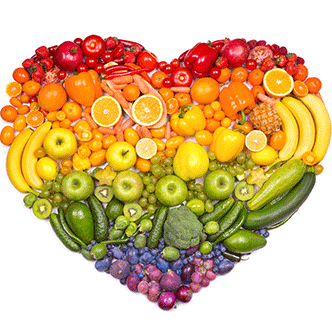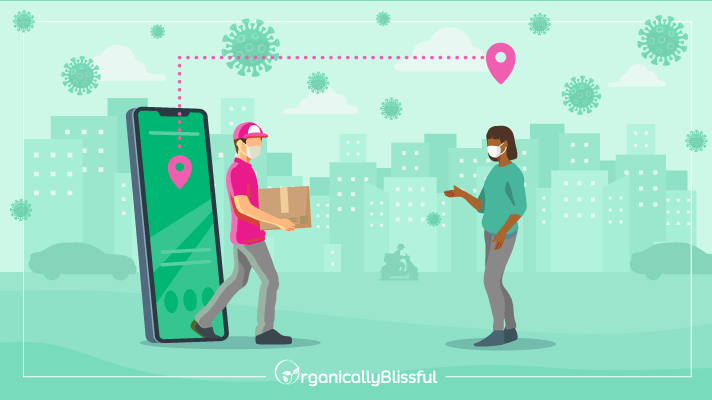
Key Takeaways from the Survey
Due to COVID-19 restrictions, mask mandates, and hesitancy regarding the safety of indoor spaces:
- Around 50% of shoppers are visiting the grocery store less often now than they did pre-pandemic with 60% only shopping once a week.
- Around 25% of respondents have begun using a grocery delivery service since the start of the pandemic.
- Only ⅔ of respondents felt the COVID-19 restrictions on grocery stores and restaurants still felt appropriate and necessary until the pandemic is under control.
- While nearly 2 out of every 3 (60%) respondents were partially or fully vaccinated, 1 out of every 5 respondents (20%) said they were not vaccinated and didn’t want to be.
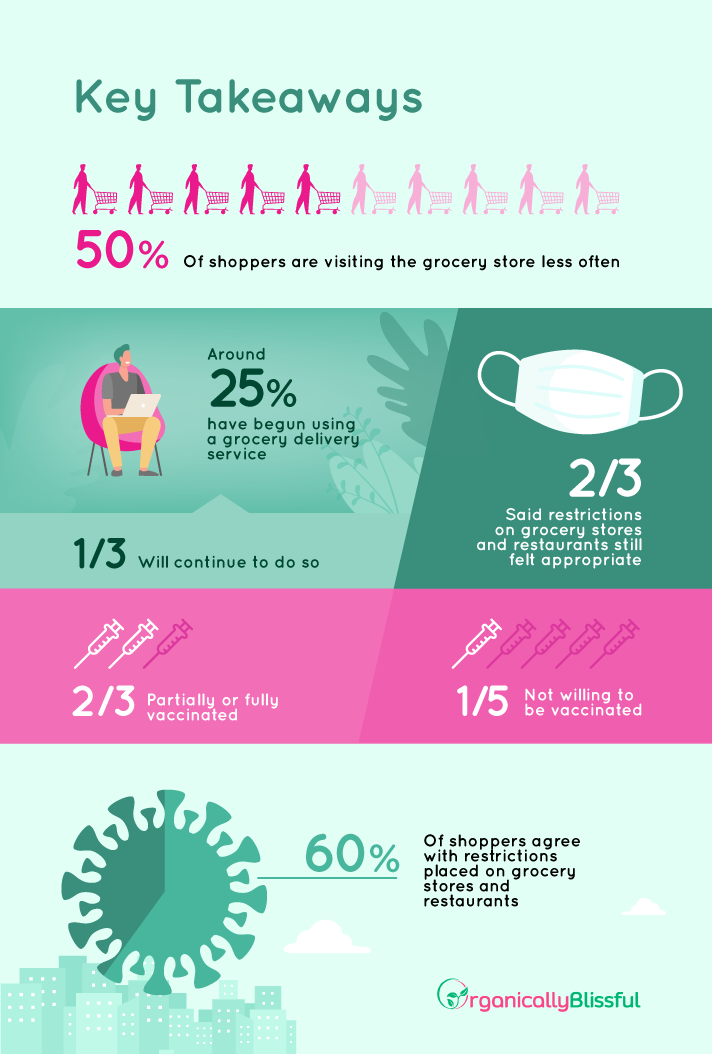
The OrganicallyBlissful team conducted a survey of 1013 Americans about how the COVID-19 pandemic has affected their grocery shopping behaviors. Respondents were asked various questions regarding their shopping habits and attitudes towards COVID-19 restrictions and vaccines.
The survey results showed that— due to fears of transmission between shoppers and the added hassle of COVID-19 restrictions— shoppers are visiting the grocery store less frequently and buying larger quantities during each trip. Additionally, the widespread shift away from in-person shopping has caused a rise in grocery store delivery services and curbside pickup, which many shoppers plan to continue using for convenience even as restrictions loosen.
The survey also reflected the wide range of views on COVID-19 restrictions and vaccinations. While most respondents supported vaccination and grocery store restrictions like reduced capacity and mask mandates, a significant portion of respondents did not support the preventative safety measures in restaurants and stores, and perhaps more importantly, did not plan to get vaccinated.
Fewer Trips to the Store Equals a Rise in Bulk Buying
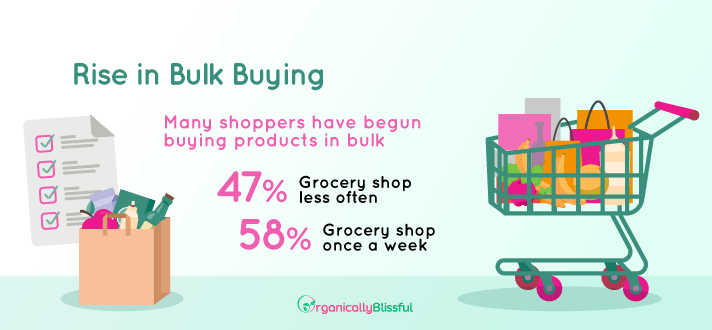
Grocery shopping has undoubtedly become more of a hassle thanks to COVID-19. As a result, consumers are hitting stores less frequently and buying more items in bulk. 47 percent of respondents reported that they grocery shop less often due to the pandemic, while 39 percent said their shopping frequency remained the same.
Thanks to restrictions such as decreased capacity, one-way aisles, and mask mandates, shoppers need to plan ahead before they get to the store. Shoppers that used to run to the store to grab just one or two ingredients to complete a recipe are making due by using substitutes or altered recipes that don’t require leaving the house. When it comes time to hit the store, more shoppers rely on grocery lists, and pre-planned meal lists to ensure they get everything they need. 58 percent of respondents grocery shop once a week, and just 23 percent make multiple trips in a week.
To further reduce their shopping frequency, many shoppers have begun buying products in bulk quantities. Additionally, this may be an after-effect of the scarcity of household paper products, pantry staples, and cleaning supplies during the early pandemic. 38 percent of respondents reported spending between $50- $100 per week on groceries, while another 38 percent spent between $100- $200.
A Widespread Increase in Takeout, Curbside Pickup, and Delivery Services
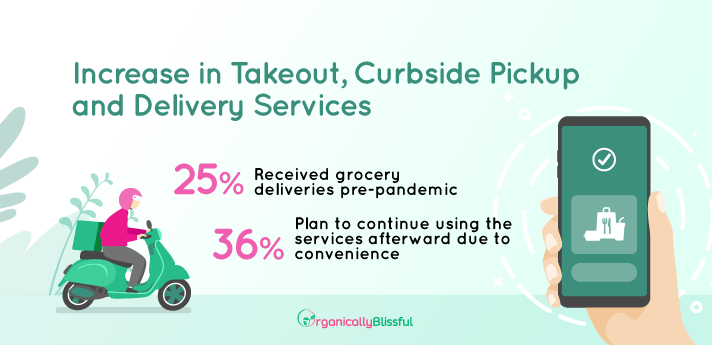
Many consumers have turned to curbside pickup and grocery delivery services to avoid the hassle and potential health risks of shopping in person. Of the 50 percent of respondents who reported they use grocery delivery services like Amazon Fresh or InstaCart, only half received grocery deliveries pre-pandemic.
In addition to lowered infection risks, these services can be time-saving and convenient, making them a popular choice among people with busy work schedules and families with small children. Of the respondents who reported using grocery delivery during the pandemic, 36 percent plan to continue using the services afterward due to convenience. 13 percent said they would not due to the added cost of delivery, suggesting that grocery delivery will be used primarily by middle and upper-class households after the pandemic.
Similarly, COVID-19 has led to an increased reliance on restaurant delivery services like UberEats, DoorDash, and Grubhub. 22 percent of respondents began using delivery only after the pandemic began. Another 25 percent reported that while they had used restaurant delivery before COVID-19, their delivery frequency has increased due to the pandemic.
Pandemic Impacts on Buying Organic
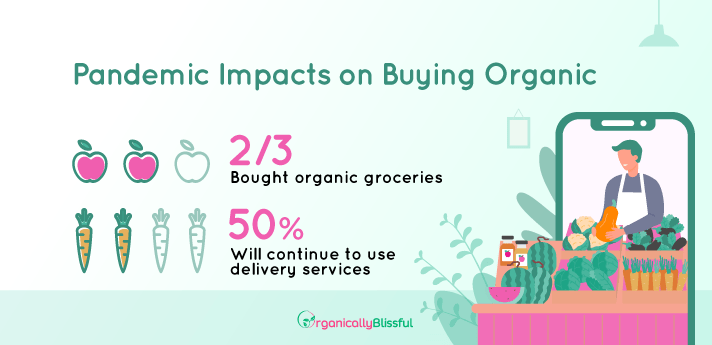
Thanks in part to accessible organic grocery stores like Whole Foods and Sprouts and delivery services like Imperfect Produce and Misfits Market, consumer interest in organic groceries is on the rise. Two-thirds of respondents to the OrganicallyBlissful survey reported buying organic groceries. Of this group of organic shoppers, only 12 percent reported buying organic products as much as possible or available. The remaining 88 percent responded that half or less of their groceries are organic.
Interestingly, half of the individuals who buy organic reported that they plan to continue to use grocery delivery services even after the pandemic dies down due to its convenience. 40 percent reported receiving grocery deliveries multiple times a week. The high delivery frequency may be attributed to shoppers seeking out fresh produce or using multiple delivery services to receive a wider variety of organic produce and grocery products.
Varied Reactions to Restrictions and Vaccination
It’s important to note that the consumers measured in the survey reflect a wide range of viewpoints on COVID-19 restrictions and vaccination. Respondents were spread throughout all regions of the United States. While the survey's primary goal was not to understand consumers’ views on COVID-19 itself, these questions helped provide context to their answers.
When asked how they felt about the COVID-19 restrictions placed on grocery stores and restaurants, 63 percent of respondents agreed that the restrictions were appropriate and should continue until the virus is under control. However, 27 percent responded that while the restrictions were appropriate during the early days of the pandemic, it was time to lift them. The remaining 10 percent found them to be inappropriate or not worth the effort.
When it came to vaccination, 40 percent of respondents were fully immunized, and another 19 percent were partially vaccinated. Of those who weren’t yet vaccinated, half reported they did not want to receive the vaccine at all.
Key Takeaways By Region
Methodology: OrganicallyBlissful surveyed more than 1,000 Americans during the month of May 2021. Full results can be found here for verification: https://www.surveymonkey.com/results/SM-8FYVMXFL9/
Author: Jenny Z on 2021-05-10.

